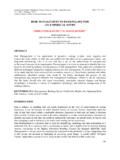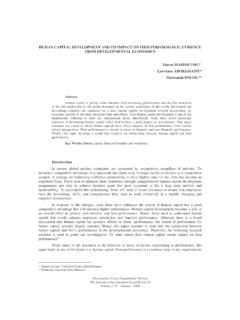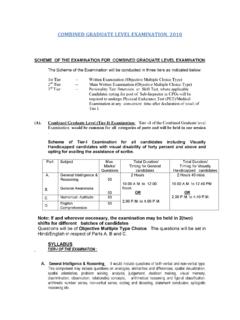Transcription of RAIL FREIGHT CAR LEASING MARKET STUDY EXECUTIVE …
1 FREIGHT Car LEASING MARKET STUDY Page ES- 1 RAIL FREIGHT CAR LEASING MARKET STUDY EXECUTIVE summary INTRODUCTION This STUDY was undertaken to provide an overview of the railcar LEASING business with the LEASING business and at what level. The scope of work involves a thorough STUDY of the rail FREIGHT car MARKET including factors that underpin railcar demand, supply and valuation. The STUDY also provides information on the major players in the rail FREIGHT car equipment LEASING business, their motives and the type of leases common to the industry. The following are brief summarizations of the major findings of the report. RAIL FREIGHT INDUSTRY HISTORY AND TRENDS This chapter provides an historical perspective on the railroad industry, including the major economic factors that underlie its performance over time, regulatory developments and the policy environment.
2 Key points that emerge from this analysis are the overwhelming trend towards industry rationalization and consolidation and the regulatory reform that made it possible. The railroad industry is composed of four Class I railroad companies and three foreign-owned companies. Together, they operate on close to 170,000 miles of track and 100,000 miles less than the system total in 1980. This decline is indicative of the general railroad industry trend towards reducing fixed operating costs. To accomplish this, railroads have downsized their ownership of capital equipment, including many types of railcars, and focused more intently on improving equipment utilization on mainline routes. Class I railroads owned million FREIGHT cars in 1980 but by 2003, this number had dwindled to just 467,000 cars. The decline has been mirrored by growth in private ownership and LEASING .
3 Private owners and LEASING companies account for the remainder of the million cars counted in 2003. The Staggers Act of 1980 completed a process of deregulation in the railroad industry that was begun in the mid-1970s. Staggers dramatically altered the financial and operating performance of the industry, primarily by opening the way for railroad firms to increase efficiencies by rationalizing operations. As a result, the rail industry, which had been fighting a losing battle with trucking for the inter-city FREIGHT MARKET , was able to begin a process of recovery that has produced at least average rates of return for investors since the mid- to late 1980s. The financial performance of the rail industry since the Staggers Act is much improved and is now more in step with broader trends in equity markets. In real terms, FREIGHT revenue per track mile rose from just under $180,000 in 1980 to close to $200,000.
4 Returns on net capital investment are now closer to if not exceeding the general MARKET averages whereas prior to 1980, returns of less than 3 percent were not uncommon. objective of helping to guide [investor] decision on whether to participate in the rail FREIGHT car FREIGHT Car LEASING MARKET STUDY Page ES- 2 Railroad output is highly cyclical and grows roughly in line with developments in real domestic product and industrial production. More recently, the rapid growth of international trade has had an important influence on railroad output. Rail companies are deeply involved in transporting primary commodities for export, and finished goods, mainly in containers, for import. Evidence of the industry s cyclicality is found in the FREIGHT car MARKET . New orders of FREIGHT cars and locomotive orders were placed at record volumes during the 1994 to 1999 period.
5 Many of these orders were placed on speculative assumptions about the growth of the economy. In 1995, the number of rail cars and locomotives in service increased for the first time in 15 years as new equipment deliveries outpaced the number of units retired. During the recessionary period between 2000 and 2002, FREIGHT car orders came to a virtual standstill and lease rates declined precipitously. Railroads compete with trucks and to a lesser extent, inland and coastal barges, pipelines and air FREIGHT services. In the ten years from 1992 to 2001, railroads increased their share of inter-city FREIGHT traffic by percentage points. This reflects a sharp improvement in operating efficiencies and the ability to pass the subsequent cost savings onto shippers. It represents a noteworthy turnaround from the poor performance of the pre-Staggers era when the rail share of inter-city FREIGHT traffic fell below 40 percent.
6 In part because of the relatively high social costs imposed by trucks in the form of pollution, noise, infrastructure wear and tear, and road congestion, government policy towards railroads has been more favorable during the past 30 years. In 1980, the Staggers Act significantly reduced the burdens imposed by the Interstate Commerce Commission (now known as the Surface Transportation Board) and helped to initiate the current trend in equipment downsizing and system rationalization. The outlook for the railroad industry is favorable. Growth will proceed moderately but will be subject to infrastructure constraints going forward. RAIL FREIGHT TRANSPORTATION DEMAND Commodity trends specific to railroads were profiled using data from government and private sources. Forecasts were provided for each of 14 broadly defined commodity groupings.
7 Details of the results of the forecasts are given in Table 3-3. Rail FREIGHT cars tend to be commodity-specific and as such, predicting demand for them is contingent upon demand for commodities they typically carry. See Table 3-1 for a detailed summary . Bulk commodities coal, chemicals, grain and aggregates, in that order, account for the largest share of railroad tonnage. In terms of car loadings, coal, chemicals, motor vehicles and grain are the top commodities. In terms of revenue per carload, lumber and wood products, pulp and allied paper products, chemicals and petroleum products are the highest earners. FREIGHT Car LEASING MARKET STUDY Page ES- 3 Growth expectations are fair to moderate. The decline in manufacturing in the has reduced demand in several commodity groups but at least some of these losses will be offset by increased international trade.
8 RAIL FREIGHT CAR MARKET TRENDS PATTERNS AND ISSUES The investigation into the railcar MARKET covers 13 types of railcar each with characteristics that differentiate them from others. This Chapter and Appendix C differentiate by railcar types several relevant valuation indicators including ownership trends, carloading and utilization, traffic summary , historical residual values, estimated fair MARKET values, fair MARKET net rental rates and estimated future MARKET values. Covered hoppers, gondolas and tank cars are the most common rail FREIGHT cars in the fleet. The most widely used method of valuation for used railcars is the monthly net lease rate. Net lease rates depend on key car loadings, average revenues per car, interest rates and new car prices. The relationship of each variable to lease rates was estimated econometrically using private industry data sources.
9 The research revealed that, average new car prices were the strongest predictor of lease rates. Statistics describing the fair MARKET value of 18-20 year old rail cars illustrate how technical change, , technological obsolescence, such as that which raises the capacity and, thus, operating efficiency of new railcars, can significantly depress the value of older cars. In 2004 prices for new railcars ranged from $57,000 for a coal gondola car to $88,000 for a 60 box car. RAIL CARS AND NEW FREIGHT CAR DELIVERIES This chapter provides a forecast of railcar deliveries over the medium term (through 2013) and the long-term (through 2020). There are two approaches to the forecasting methodology. First, a private railcar forecasting company (Rail Theory Forecasts) provides projected railcar deliveries to 2013, a ten-year time horizon.
10 These forecasts were supplemented by a structural econometric model that integrates prices, interest rates and income to predict railcar deliveries through 2020. The Chapter and Appendix provide detailed results. The average capacity of a railcar is significantly higher today than prior to 1980 and this has a depressing effect on the number of railcar deliveries. Our models and analyses suggest that recent deliveries of new railcars have weakened because of speculative overbuilding in the mid- to late-1990s and increasing capacity of new deliveries that reduce the number of cars required to replace those being retired. This has depressed their projected growth over the medium (ten years) and long-term (15 years). Deliveries of gondola cars will experience the fastest growth of percent per year through 2020, followed by plastic pellets covered hoppers ( ) and autoracks ( ).







